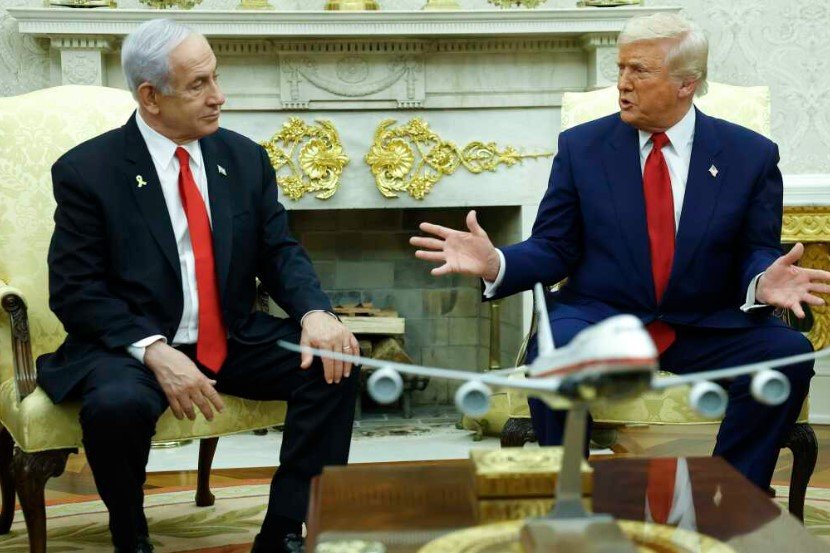Trump and Netanyahu Hold Surprise Second Meeting as Gaza Ceasefire Hopes Rise
A quiet but significant hour-long meeting between President Trump and Prime Minister Netanyahu signals urgency in Gaza peace talks, as death toll soars.
It wasn’t on the official calendar, and reporters weren’t invited in. But late Tuesday evening, U.S. President Donald Trump and Israeli Prime Minister Benjamin Netanyahu sat down—again—for their second face-to-face meeting in 24 hours, this time behind closed doors, to talk Gaza.
The unscheduled meeting, which lasted just over an hour, came as Israeli airstrikes in Gaza killed at least 95 more Palestinians. The renewed contact and the timing of it have only deepened speculation that a ceasefire may be closer than expected.
A White House Dinner, Then a Private Huddle
The first meeting between Trump and Netanyahu this week came over dinner Monday night. Sources familiar with the gathering described it as “cordial but intense,” with the situation in Gaza dominating the table.
Less than 24 hours later, the two men met again—this time with fewer aides, no fanfare, and no cameras. The White House declined to provide a readout.
For Netanyahu, this marks his third trip to Washington since Trump began his second term in January. That’s telling in itself.

U.S. Pushes for Truce as Gaza Crisis Deepens
Trump has made no secret of wanting a resolution in Gaza—and fast. The president told reporters on Tuesday that Netanyahu “wants to get it solved,” and “I want to get it solved, and I think the other side wants to.”
Those comments come as Israel faces growing international backlash over its military operations. Humanitarian groups say Gaza is in tatters—hospitals overwhelmed, fuel running out, food scarce.
One U.N. official warned this week that Gaza is nearing a “critical point.” Another called the Israeli blockade “collective punishment.”
Still, Trump seems to believe there’s an opening.
Steve Witkoff’s Role in the Background
Much of the behind-the-scenes diplomacy is being steered by Trump’s Middle East envoy, Steve Witkoff, a billionaire real estate developer with limited diplomatic experience but close ties to both the president and Israeli leadership.
Witkoff said in a radio interview Tuesday morning that “significant gaps” between Israel and Hamas had narrowed in the last 72 hours. Though he didn’t offer details, sources familiar with the talks confirmed to Bloomberg that hostage arrangements and aid delivery routes remain the biggest hurdles.
There’s cautious optimism—but also deep fatigue.
• One senior U.S. official involved in the talks described the negotiations as “like watching two people try to patch a tire while it’s still spinning down the highway.”
Israel Faces Pressure From All Sides
Back in Israel, Netanyahu is under pressure from multiple directions. His security cabinet is divided, with hawks demanding a full offensive to eliminate Hamas, while moderates worry about the long-term fallout.
Public opinion is also shifting. With mounting casualties and no clear endgame, frustration is growing. Tel Aviv and Jerusalem have seen a rise in anti-war demonstrations, including from families of hostages still believed to be held in Gaza.
Meanwhile, the Israeli military continues its operations.
On Tuesday, Israeli air raids reportedly hit Rafah and parts of northern Gaza, where displaced families had taken shelter. Local officials say more than 30 children were killed in those strikes alone.
The International Stakes Keep Rising
This isn’t just a regional fight anymore. Iran has threatened retaliation if Israel expands operations, while Hezbollah remains on alert in Lebanon’s south. The U.S. has kept two aircraft carriers in the eastern Mediterranean for months.
A ceasefire deal—even a temporary one—could help dial down wider tensions, at least for now.
But risks remain. Past truces have collapsed in days. And neither side has shown much appetite for lasting compromise.
The stakes, however, are brutally real.
| Key Death Toll Figures in Recent Gaza Conflict |
|---|
| Total Palestinians killed (Oct 2023–July 2025) |
| Children among the dead |
| Israeli casualties since Oct 7, 2023 |
| Hostages still held in Gaza |
| Displaced Palestinians |
Netanyahu’s Gamble, Trump’s Calculus
There’s no denying that politics are also at play.
For Netanyahu, domestic turmoil—including corruption trials and political gridlock—has dented his long-standing grip on power. Securing a ceasefire and return of hostages could help him claw back public support.
Trump, meanwhile, is balancing global diplomacy with a heated re-election campaign. A Gaza breakthrough—especially if he can claim credit—could bolster his image as a dealmaker.
One former White House official put it bluntly: “Trump wants a win. Netanyahu needs one.”
What Happens Next?
Hard to say. There’s talk of a framework deal that would see:
• A six-week pause in fighting
• The release of sick, elderly, and female hostages
• Delivery of fuel and medical aid via Egypt
• Negotiations on long-term arrangements during the pause
But Hamas hasn’t publicly endorsed anything yet. And Israeli officials remain tight-lipped about next steps.
Still, two back-to-back meetings between Trump and Netanyahu within 24 hours suggest something is moving.
And for the families stuck waiting—for peace, for answers, for bodies—that’s something.
